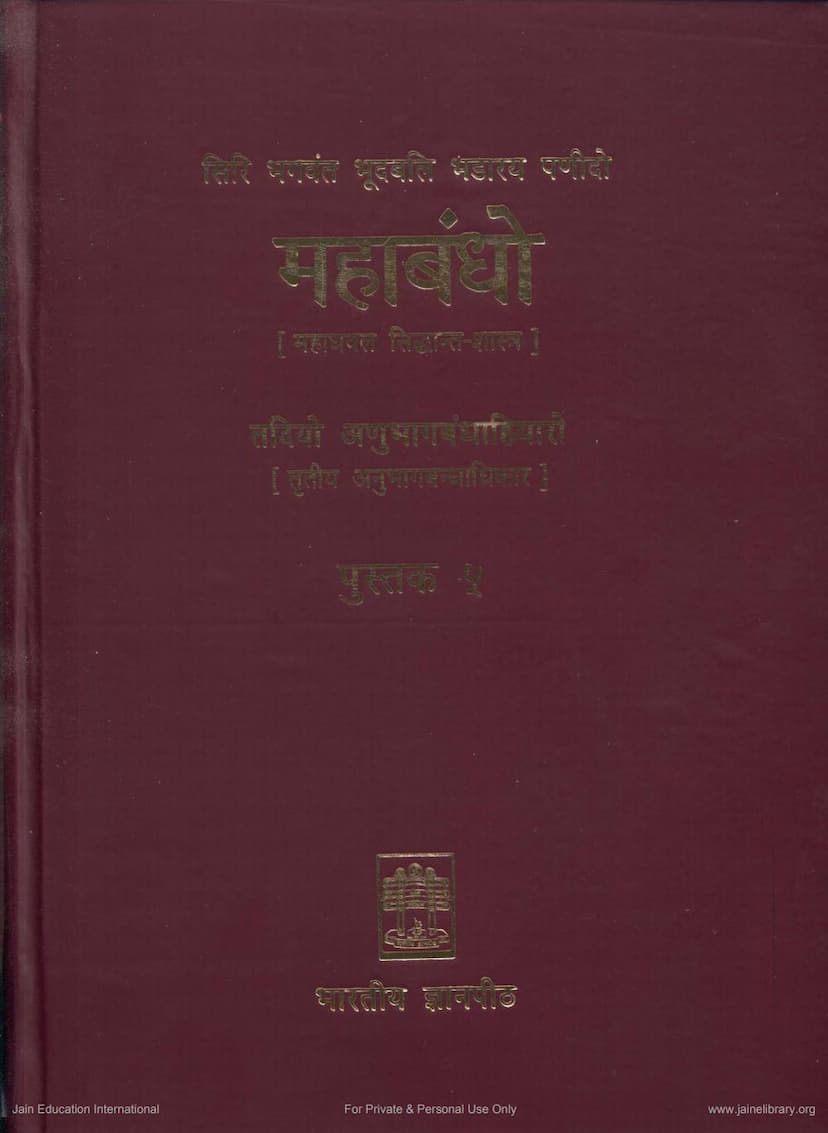Mahabandho Part 5
Added to library: September 2, 2025

Summary
This is a summary of Mahabandho Part 5, authored by Bhutbali and translated/edited by Pt. Phoolchandra Siddhantashastri, published by Bharatiya Gyanpith. This volume is the fifth in a series on the Mahadhavala siddhanta shastra, specifically focusing on the Anubhaga-bandhadhikara (chapter on the binding of intensity).
Overall Scope:
This book is a highly detailed and technical explanation within Jain philosophy, specifically concerning the karmic influx (Asrava) and the binding of karmas based on their intensity (Anubhaga-bandha). It delves into complex concepts like:
- Karmic Bondage (Bandha): How different souls bind various types of karmas.
- Intensity of Karmas (Anubhaga): The degree or quality of the karmic fruits experienced.
- Types of Bondage: Exploring concepts like Bhujagar Bandha (bondage where intensity increases over time), Alpatara Bandha (bondage where intensity decreases), Avasthita Bandha (bondage where intensity remains constant), and Avaktavya Bandha (inexpressible bondage).
- Stages of Souls: Analyzing how the type and intensity of karmic bondage vary based on the soul's stage of spiritual development (Gunasthana), senses (Indriyas), mind (Yoga), introspection (Kashaya), knowledge (Jnana), faith (Darshana), life span (Ayu), body type (Sharira), and even leshyas (colors of the soul).
- Specific Karmas: Detailed analysis of the bonding and intensity of all 148 karmas (Prakritis) as described in Jain scripture.
- Variations based on Circumstances: Examining how these karmic processes differ across various classifications of living beings (from one-sensed to omniscient souls) and even across different spiritual states and stages.
Key Concepts Explained in Part 5:
While the provided text is extensive and covers many intricate details, the core focus of this volume appears to be on the Sannikarsa (proximity or concomitance) and Alpabahutva (quantitative comparison) of different karmic states, particularly concerning the intensity of karmic bondage (Anubhaga-bandha).
-
Sannikarsa: This section meticulously details which karmas are bound together when a soul binds a particular karma with a specific intensity. It describes whether other karmas are bound with the same intensity, a lesser intensity (anantaguna hina), or a greater intensity (anantaguna abhyadhika). The text explores these relationships across various classifications of beings and their states. For example, it details which other karmas are bound when a soul binds the highest intensity of Jnanavaran (knowledge-obscuring karma) or when it binds the lowest intensity of the same. This is a complex analysis involving the interaction of different karmic types.
-
Alpabahutva: This section quantifies the relative number of souls in different states of bondage. It compares the number of souls binding certain karmas with maximum intensity versus minimum intensity, or maximum versus moderate intensity, etc. This involves detailed numerical comparisons (e.g., infinite, innumerable, countless) based on various classifications of souls.
-
Bhujagar Bandha, Alpatara Bandha, Avasthita Bandha, Avaktavya Bandha: These are crucial concepts within this section, defining different modes of karmic intensity.
- Bhujagar Bandha: Intensity increases over time.
- Alpatara Bandha: Intensity decreases over time.
- Avasthita Bandha: Intensity remains constant.
- Avaktavya Bandha: Inexpressible or indeterminate intensity. The text likely details which souls bind these types of karmas under which circumstances.
-
Kalanugama (Time Aspect): This section likely discusses the duration of these karmic bondage types.
-
Kshetra Anugama (Spatial Aspect): This section likely discusses the spatial extent of the karmic bondage experienced by souls.
-
Bhava Anugama (Attitudinal Aspect): This section likely discusses the mental and emotional states of souls binding karmas.
Publisher and Series:
The Moortidevi Jain Granthamala series by Bharatiya Jnanpith is dedicated to publishing ancient Jain literature in its original forms (Prakrit, Sanskrit, Apabhramsha) along with translations into modern languages. This volume, being part of the Prakrit Grantha series, presents a critical edition and Hindi translation, making this complex philosophical text accessible to a wider audience.
In essence, Mahabandho Part 5 is a profound exploration of the intricate mechanics of karma in Jainism, focusing on the intensity of karmic binding and its quantitative distribution across the vast spectrum of spiritual evolution.